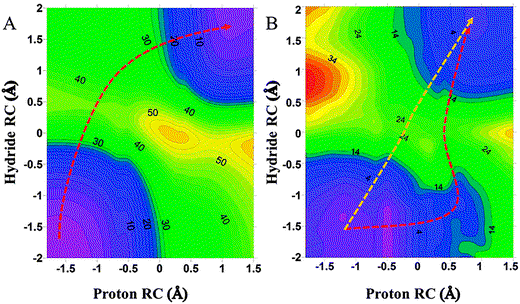
Abstract
In the present work, we studied the mechanism of L-lactate oxidation by flavocytochrome b2 (Fcb2) using molecular dynamics simulations with a hybrid Quantum Mechanics/Molecular Mechanics (QM/MM) scheme. We initially performed simulations at the QM(AM1)/MM level and improved our results with single-point corrections using density functional theory (DFT) methods. Free energy surfaces were calculated under the hydride transfer hypothesis, which involves the transfer of the lactate hydroxyl proton to H373 and the substrate αH atom as a hydride to the flavin mononucleotide (FMN) prosthetic group in the active site. We modeled four systems: the wild-type enzyme with R289 in distal or proximal conformations (observed in crystal structures) and the D282N and Y254L variants (with R289 in a distal position). Our simulations revealed the influence of the environment on the catalytic mechanism, showing a step-wise process in the wild-type enzyme with R289 in a distal position and a concerted mechanism in the other systems. In the step-wise mechanism, hydride transfer to flavin occurs only after proton transfer from the substrate to H373. Changes in the electrostatic field around L-lactate or H373 were found to disfavor the highly charged complex resulting from this proton transfer. Additionally, simulations of the Y254L variant highlighted the impact of steric changes on the mechanism.